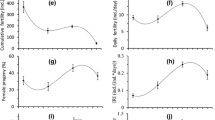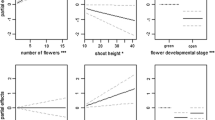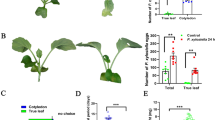Abstract
The wild crucifers,Rorippa indica andLepidium virginicum, are known to serve as host plants for the diamondback moth (DBM),Plutella xylostella, but they are less suitable than the preferred cultivated cruciferous plant, cabbage, in terms of adult body size and fecundity. The life history traits and flight activity of DBM adults grown on various host plants were investigated. The adults thus reared on each host plant were divided into three size groups (small, medium and large). In general, female adults grown on the wild crucifers were less fecund and lived longer than those reared on cabbage. Flight activity was higher in adults grown on wild crucifers than in those reared on cabbage. Male adults flew longer than females. Fecundity, longevity, flight activity and morphometrical characters of adults were positively correlated with pupal weight in individuals reared on the same host plant. A negative relationship was found between fecundity and flight activity in females of the same size group, but a positive one was observed in females reared on the same host plant.
Similar content being viewed by others
References
Casey, T. M. (1989) Oxygen consumptions during flight. pp. 257–272.In G. J. Goldsworthly and C. H. Wheeler (eds.)Insect flight. CRC Press, Florida.
Hackett, D. S. (1980)Studies on the biology of Helicoverpa armigerain the Sudan Gezira. Ph.D. thesis, University College, North Wales, Bangor, Wales.
Harcout, D. G. (1986) Population dynamics of the diamondback moth in southern Ontario. pp. 3–15.In N. S. Talekar and T. D. Griggs (eds.)Diamondback moth management. AVRDC, Taiwan.
Lewis, T. and L. R. Taylor (1967)Introduction to experimental ecology. Academic Press. London.
Miyahara, Y. (1987) Simultaneous trap catched of the oriental armyworm and the diamondback moth during the early flight season at Morioka.Japanese Journal of Applied Entomology and Zoology 31: 138–143. (in Japanese with English summary).
Mollar, J. (1988) Investigations on a laboratory culture of the diamondback moth,Plutella maculipennis (Curt.) (Lepidoptera: Tinaeidae). 1. Life history parameters: Hatching, pupation, emergence, copulation and oviposition.Journal of Applied Entomology 105: 360–373.
Muhamad, O., R. Tsukuda, Y. Oki, K. Fujisaki and F. Nakasuji (1994) Influence of wild crucifers on life history traits and flight ability of diamondback moth,Plutella xylostella (Lepidoptera: Yponomeutidae),Researches on Population Ecology 36: 53–62.
Natsuhara, Y. (1983) The influences of food and photoperiod on flight activity and reproduction of the bean bug,Riptortus clavatus Thunberg (Heteroptera: Coreidae).Applied Entomology and Zoology 18: 392–400.
Risebrow, A. and A. F. Dixon (1987) Nutritional ecology of phloem-feeding insects. pp. 421–446.In F. Slansky Jr. and J. G. Rodrigez (eds.)Nutritional ecology of insects, mites, spiders and related invertebrates. John Wiley & Sons, New York.
Shirai, Y. (1993a) Factors influencing flight ability of male adults of the diamondback moth,Plutella xylostella with special reference to temperature conditions during the larval stage.Applied Entomology and Zoology 28: 291–301.
Shirai, Y. (1993b) Comparison of longevity and flight activity in wild and laboratory reared male adults of the diamondback moth,Plutella xylostella (L.) (Lepidoptera: Yponomeutidae).Applied Entomology and Zoology 28: 578–590.
Shirai, Y. (1995) Longevity, flight ability and reproductive performance of the diamondback moth,Plutella xylostella (L.) (Lepidoptera: Yponomeutidae) related to adult body size.Researches on Population Ecology 37: 269–277.
Solbreck, C. and I. Pehrson (1980) Relation between environment, migration and reproduction in a seed bug,Neacoryphus bicrucis (Say) (Heteroptera: Lygaeidae).Oecologia 43: 51–62.
Talekar, N. S. and A. M. Shelton (1993) Biology, ecology, and management of diamondback moth.Annual Review of Entomology 38: 275–301.
Wakisaka, S., R. Tsukuda and F. Nakasuji (1991) Life tables of the diamondback moth,Plutella xylostella (L.) (Lepidoptera: Yponomeutidae) and effects of rainfall, temperature and host plants on survival and reproduction,Japanese Journal of Applied Entomology and Zoology 35: 115–122. (in Japanese with English summary)
Yamada, H. (1983) The percentage of population and emergence, fecundity of the diamondback moth fed on cruciferous weeds.Proceedings of Kansai Plant Protection Society 25: 53. (in Japanese)
Yamada, H. and K. Umeya (1972) Seasonal changes in wing length and fecundity of the diamondback moth,Plutella xylostella (L.).Japanese Journal of Applied Entomology and Zoology 16: 180–186. (in Japanese with English summary)
Yamada, H., K. Kawasaki and T. Koshihara (1980) Relations between development and fecundity of diamondback moth and growing stages of cabbage.Proceeding of Kansai Plant Protection Society 22: 54. (in Japanese)
Author information
Authors and Affiliations
Rights and permissions
About this article
Cite this article
Begum, S., Tsukuda, R., Fujisaki, K. et al. The effects of wild cruciferous host plants on morphology, reproductive performance and flight activity in the diamondback moth,Plutella xylostella (Lepidoptera: Yponomeutidae). Res Popul Ecol 38, 257–263 (1996). https://doi.org/10.1007/BF02515735
Received:
Accepted:
Issue Date:
DOI: https://doi.org/10.1007/BF02515735




